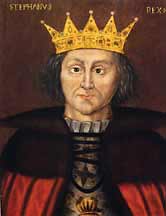THE BATTLE OF
HUNMANBY 1143-44

King Stephen (1135-54 AD)
Ces Mowthorpe. Copyright 2004
In England, it is safe to state that most communities were involved in some sort of ‘battle’ - either a brief skirmish or between two armies such as Marston Moor - but relatively few are recorded.
Hunmanby’s battle is mentioned in the annals of Bridlington Priory. Bridlington Priory was founded by Walter de Gant, son of Hunmanby’s first Norman Lord of the Manor Gilbert de Gant and Walter’s son Gilbert (the second Gilbert de Gant) was born there. Hence the connection between the Priory and the de Gant family.
During the reign of King Stephen troubled times arose. The son of William the conqueror’s daughter Adela and nephew of King Henry 1. Stephen was, due to Henry 1. having no heir, elected to the throne in 1135. However, Henry 1. had a daughter Matilda who disputed Stephen’s right to the English throne and she landed with substantial forces. Briefly, the country became divided with the West supporting Matilda and London and the East behind Stephen. Eventually Matilda was forced to flee but meanwhile the Baron’s had taken sides causing much unrest and fighting between themselves.
One William le Gros, Earl of Albemarle, (a Manor in Holderness near Beverley and now ‘lost’) and Gilbert de Gant of Hunmanby were on opposite sides. During the period 1143 -1144 William le Gros advanced on Bridlington Priory, expelled the Abbot and clergy, fortified the building and began a campaign against Gilbert. This culminated in a battle during which Gilbert was defeated and his ‘castle’ at Hunmanby totally destroyed.
William le Gros later, when the troubled times ceased, repented and gave to Bridlington Priory six parcels of land, one in Boynton and the rest in various parts of Holderness.
The destruction of the de Gant ‘castle’ (it was a wooden structure surrounded by a dry moat, the northern part of which the main road to the west today passes, after leaving Church Hill) and known in Norman times as a ‘motte and bailey’ is an interesting point.

Where did the de Gant family live afterwards?
Did they rebuild the castle in some form ?
Or did they establish residence in what today is the Low Hall Manor on Sheepdyke lane ?
Unfortunately we possess no records for this period
other than the shields in ‘All Saint’s Church’ which confirm that Gilbert’s son Hugh Grant was Lord of the Hunmanby manor well into the 13th century.


